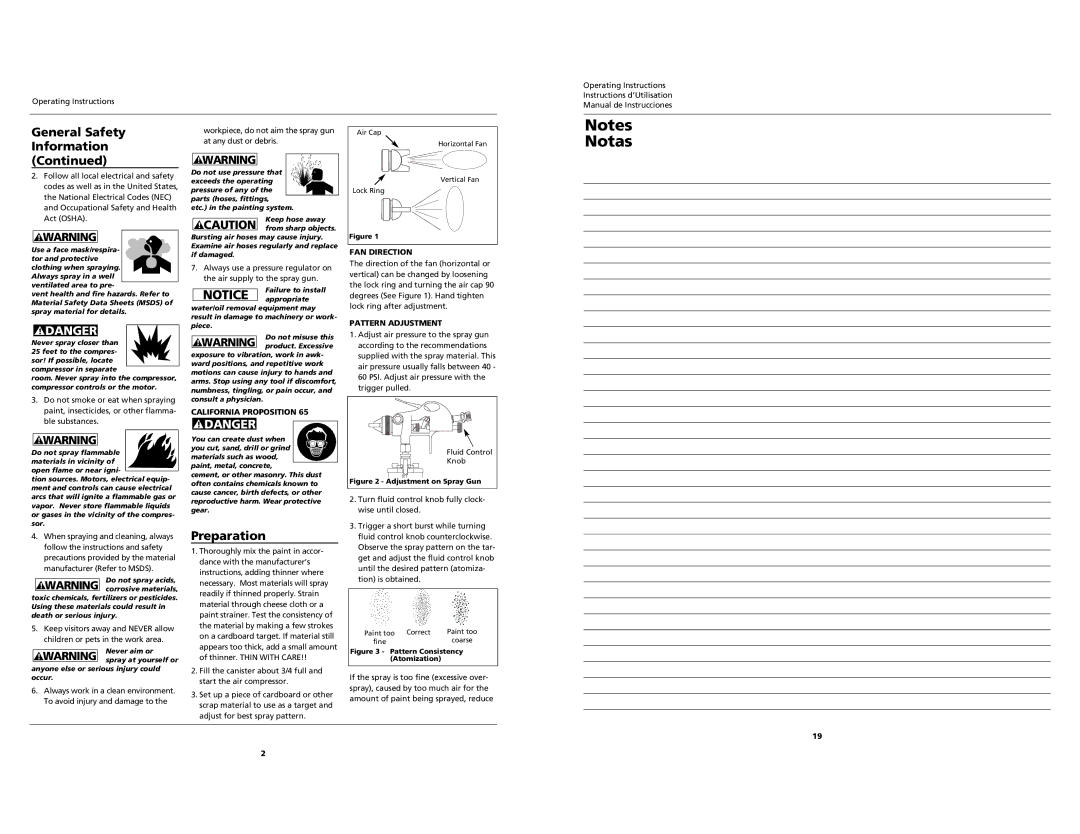
Operating Instructions
Operating Instructions Instructions d’Utilisation Manual de Instrucciones
General Safety Information (Continued)
2.Follow all local electrical and safety codes as well as in the United States, the National Electrical Codes (NEC) and Occupational Safety and Health Act (OSHA).
! WARNING
Use a face mask/respira- tor and protective
clothing when spraying. Always spray in a well ventilated area to pre-
vent health and fire hazards. Refer to Material Safety Data Sheets (MSDS) of spray material for details.
!DANGER
Never spray closer than 25 feet to the compres- sor! If possible, locate compressor in separate
room. Never spray into the compressor, compressor controls or the motor.
3.Do not smoke or eat when spraying paint, insecticides, or other flamma- ble substances.
! WARNING
Do not spray flammable materials in vicinity of open flame or near igni-
tion sources. Motors, electrical equip- ment and controls can cause electrical arcs that will ignite a flammable gas or vapor. Never store flammable liquids or gases in the vicinity of the compres- sor.
4.When spraying and cleaning, always follow the instructions and safety precautions provided by the material manufacturer (Refer to MSDS).
Do not spray acids,
!WARNING corrosive materials, toxic chemicals, fertilizers or pesticides. Using these materials could result in death or serious injury.
5.Keep visitors away and NEVER allow children or pets in the work area.
Never aim or
spray at yourself or
anyone else or serious injury could occur.
6.Always work in a clean environment. To avoid injury and damage to the
workpiece, do not aim the spray gun at any dust or debris.
! WARNING
Do not use pressure that exceeds the operating pressure of any of the
parts (hoses, fittings,
etc.) in the painting system.
Keep hose away
! CAUTION from sharp objects. Bursting air hoses may cause injury. Examine air hoses regularly and replace if damaged.
7.Always use a pressure regulator on the air supply to the spray gun.
Failure to install
!NOTICE appropriate water/oil removal equipment may result in damage to machinery or work- piece.
Do not misuse this
!WARNING product. Excessive exposure to vibration, work in awk- ward positions, and repetitive work motions can cause injury to hands and arms. Stop using any tool if discomfort, numbness, tingling, or pain occur, and consult a physician.
CALIFORNIA PROPOSITION 65
!DANGER
You can create dust when you cut, sand, drill or grind materials such as wood, paint, metal, concrete,
cement, or other masonry. This dust often contains chemicals known to cause cancer, birth defects, or other reproductive harm. Wear protective gear.
Preparation
1.Thoroughly mix the paint in accor- dance with the manufacturer’s instructions, adding thinner where necessary. Most materials will spray readily if thinned properly. Strain material through cheese cloth or a paint strainer. Test the consistency of the material by making a few strokes on a cardboard target. If material still appears too thick, add a small amount of thinner. THIN WITH CARE!!
2.Fill the canister about 3/4 full and start the air compressor.
3.Set up a piece of cardboard or other scrap material to use as a target and adjust for best spray pattern.
Air Cap
Horizontal Fan
Vertical Fan
Lock Ring
Figure 1
FAN DIRECTION
The direction of the fan (horizontal or vertical) can be changed by loosening the lock ring and turning the air cap 90 degrees (See Figure 1). Hand tighten lock ring after adjustment.
PATTERN ADJUSTMENT
1.Adjust air pressure to the spray gun according to the recommendations supplied with the spray material. This air pressure usually falls between 40 - 60 PSI. Adjust air pressure with the trigger pulled.
Fluid Control
Knob
Figure 2 - Adjustment on Spray Gun
2.Turn fluid control knob fully clock- wise until closed.
3.Trigger a short burst while turning fluid control knob counterclockwise. Observe the spray pattern on the tar- get and adjust the fluid control knob until the desired pattern (atomiza- tion) is obtained.
Paint too | Correct | Paint too |
fine |
| coarse |
Figure 3 - Pattern Consistency (Atomization)
If the spray is too fine (excessive over- spray), caused by too much air for the amount of paint being sprayed, reduce
Notes
Notas
19
2
